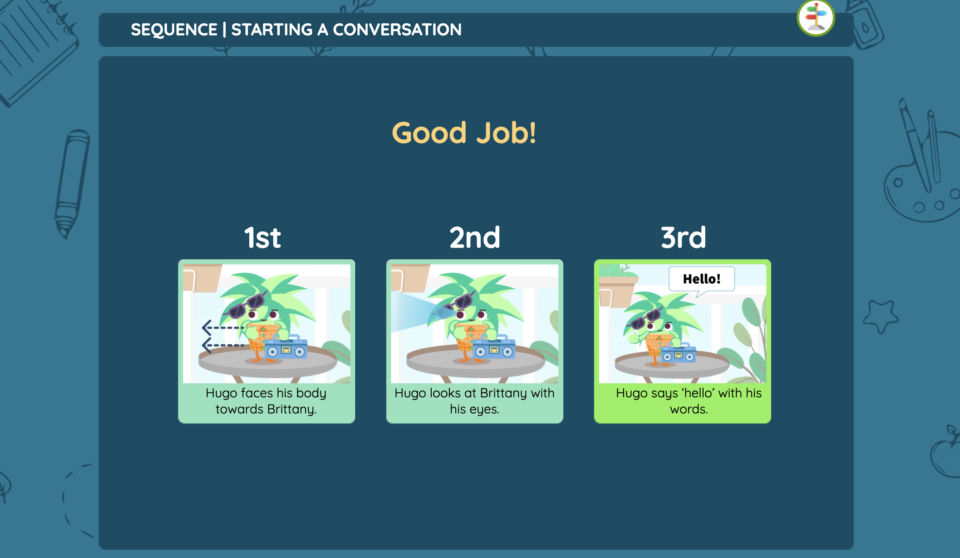
Teaching preschoolers to start a conversation can be challenging, especially when they’re still developing their social and communication abilities. As educators, we understand the importance of equipping young students with foundational social skills that help them interact with their peers, express themselves confidently, and engage in meaningful dialogues. Everyday Speech offers an excellent solution to teach these critical skills through their interactive sequencing activity designed to help preschoolers learn how to start a conversation.
This digital tool breaks down the steps of initiating conversations into easy-to-understand visual sequences, guiding students through every essential step. The activity uses playful plant characters and clear visual prompts to encourage preschoolers to practice these steps in a fun and engaging way. In this blog, we will dive into how you can use this resource to promote effective communication among your preschool students.
Why Teaching Preschoolers to Start a Conversation is Crucial
Starting a conversation is a fundamental skill that enables children to make new friends, express their thoughts, and develop relationships. For preschoolers, initiating communication can be difficult due to a lack of experience, confidence, or understanding of social cues. This is why it’s vital to provide them with structured guidance on how to properly engage with others. Teaching conversation skills at an early age sets the stage for better communication later in life, helping children navigate social situations in and out of the classroom.
Here are some key reasons why conversation skills are important for preschoolers:
- Builds Confidence: Knowing how to initiate conversations gives young children the confidence to engage with peers and adults.
- Develops Social Awareness: Learning how to start a conversation helps children understand the appropriate times and ways to interact with others.
- Improves Language Skills: Practicing conversation starters boosts vocabulary, sentence structure, and overall language development.
- Promotes Emotional Expression: Conversation allows children to express their feelings, ask questions, and share ideas, contributing to emotional growth.
Everyday Speech’s Teaching Preschoolers to Start a Conversation interactive activity helps introduce these concepts in a way that preschoolers can easily grasp and apply.

How the Interactive Sequencing Activity Works
The Interactive Sequencing Activity on starting a conversation takes students through a series of steps they need to follow when initiating a conversation with a peer or adult. The activity presents simple, step-by-step instructions paired with visual representations of the process.
Key Components of the Activity:
- Visual Steps: The activity uses engaging plant characters, such as Hugo the Plant, to model the correct actions for starting a conversation. Each sequence clearly shows what the child should do first, second, and third.
- Clear Prompts: Preschoolers are given direct prompts, such as “Say hello.” These steps are easy to follow and provide the necessary structure for children to understand how conversations start.
- Hands-On Engagement: Children are invited to actively participate by dragging and dropping the sequence cards into the correct order. This hands-on interaction reinforces the lesson and helps them retain the steps in a fun way.
The combination of visual aids, prompts, and interactivity keeps preschoolers engaged and makes learning conversation skills both accessible and enjoyable.
Implementing the Activity in Your Classroom
Incorporating this activity into your preschool curriculum is simple and can have a lasting impact on your students’ social skills. Here’s how you can integrate the Teaching Preschoolers to Start a Conversation activity into your daily lessons:
1. Introduce the Concept of Conversations
Start by explaining to your students what a conversation is and why it’s important. Use real-life examples they can relate to, such as talking to a friend about a favorite toy or asking a teacher a question. This sets the stage for the lesson and gets children thinking about how they already use communication.
2. Demonstrate with the Sequencing Activity
Next, use the Everyday Speech sequencing activity as a visual demonstration. Project the activity onto a screen or have students engage with it individually on tablets. Walk them through the steps of starting a conversation, showing how Hugo faces his friend, uses visual referencing, and says “hello.” Encourage students to practice.
3. Engage in Role-Playing
After completing the interactive activity, encourage students to role-play with each other. Have them practice initiating a conversation in pairs or small groups. You can even set up scenarios where students can take turns being the one to start the conversation. This real-world application helps reinforce the skills they learned from the activity.
4. Reflect on the Lesson
End the lesson by asking students what they learned and how they felt when starting a conversation. Reflection allows students to internalize the lesson and apply it in the future.
Unlock all of our preschool materials by signing up for your free trial today – no credit card required!
Access the full Social Communication Curriculum HERE!
Instant access to thousands of no-prep social skills activities, over 1000+ video lessons, and engaging games designed to enhance learning and development.
Conclusion: Building Strong Communication Foundations
Teaching preschoolers to start a conversation is a valuable skill that lays the groundwork for their social development. Everyday Speech’s interactive sequencing activity is a fantastic resource for educators looking to introduce this essential skill in an engaging and age-appropriate way. Through clear visuals, interactive prompts, and hands-on learning, preschoolers can gain the confidence they need to communicate effectively with their peers.
By incorporating this activity into your curriculum, you’re helping your students build strong foundations for their future social interactions. The best part? These conversation skills will serve them well beyond the classroom, fostering a lifetime of successful communication.
Sample Video
Students learn best by watching others their same-age model the behavior! Check out a sample video modeling lesson below. We offer our entire Social-Emotional Learning platform free for 14 days here!
Related Blog Posts:
Preschool and Kindergarten Social Communication and SEL Materials are Now Live!
Free Preschool Sharing Material
How to Support SEL for Preschoolers





